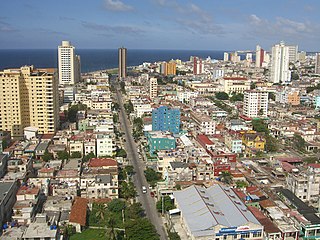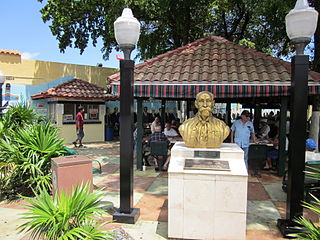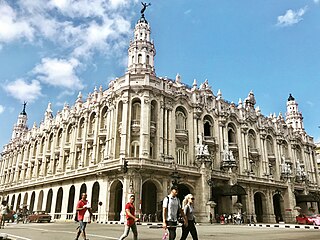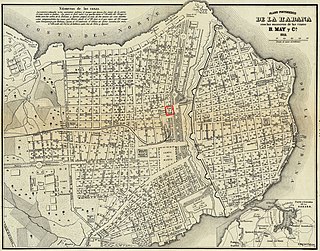
Havana is the capital and largest city of Cuba. The heart of the La Habana Province, Havana is the country's main port and commercial center. It is the most populous city, the largest by area, and the second largest metropolitan area in the Caribbean region. The population in 2002 was 2,137,847 inhabitants, and its area is 728.26 km2 (281.18 sq mi) for the capital city side and 8,475.57 km2 for the metropolitan zone.

José Julián Martí Pérez was a Cuban nationalist, poet, philosopher, essayist, journalist, translator, professor, and publisher, who is considered a Cuban national hero because of his role in the liberation of his country from Spain. He was also an important figure in Latin American literature. He was very politically active and is considered an important philosopher and political theorist. Through his writings and political activity, he became a symbol of Cuba's bid for independence from the Spanish Empire in the 19th century, and is referred to as the "Apostle of Cuban Independence". From adolescence on, he dedicated his life to the promotion of liberty, political independence for Cuba, and intellectual independence for all Spanish Americans; his death was used as a cry for Cuban independence from Spain by both the Cuban revolutionaries and those Cubans previously reluctant to start a revolt.

Little Havana is a neighborhood of Miami, Florida, United States. Home to many Cuban exiles, as well as many immigrants from Central and South America, Little Havana is named after Havana, the capital and largest city in Cuba.

Santa Clara is the capital city of the Cuban province of Villa Clara. It is centrally located in the province and Cuba. Santa Clara is the fifth-most populous Cuban city, with a population of nearly 245,959.

Alicia Alonso was a Cuban prima ballerina assoluta and choreographer whose company became the Ballet Nacional de Cuba in 1955. She is best known for her portrayals of Giselle and the ballet version of Carmen.
"Quiéreme mucho" is a criolla-bolero composed in 1911 by Gonzalo Roig with lyrics by Ramón Gollury and Agustín Rodríguez. The song was inspired by Roig's wife, Blanca Becerra, and premiered in Havana in 1911 without much success. In 1917, it was included in the sainete El servicio militar obligatorio and performed by Becerra and Rafael Llorens to critical acclaim. Roig published and sold the rights to the song in 1921, and the first recording was made in the United States by singer Tito Schipa in 1923. The English version, "Yours", was published in 1931 in the United States. It featured lyrics in English written by Albert Gamse and Jack Sherr. Both versions have been extensively recorded and arranged by different musicians, becoming Latin music standards.

Plaza de la Revolución, "Revolution Square", is a municipality and a square in Havana, Cuba.

Gran Teatro de La Habana is a theater in Havana, Cuba, home to the Cuban National Ballet. It was designed by the Belgian architect Paul Belau and built by Purdy and Henderson, Engineers in 1914 at the site of the former Teatro Tacón. Its construction was paid for by the Galician immigrants of Havana to serve as a community-social center. Located in the Paseo del Prado, its facilities include theatres, a concert hall, conference rooms, a video screening room, as well as an art gallery, a choral center and several rehearsal halls for dance companies. It hosts the International Ballet Festival of Havana every two years since 1960.

The Teatro Nacional de Cuba is a theatre building in Havana, Cuba, on Plaza de la Revolución.

Rita Aurelia Fulcida Montaner y Facenda, known as Rita Montaner, was a Cuban singer, pianist and actress. In Cuban parlance, she was a vedette, and was well known in Mexico City, Paris, Miami and New York, where she performed, filmed and recorded on numerous occasions. She was one of Cuba's most popular artists between the late 1920s and 1950s, renowned as Rita de Cuba. Though classically trained as a soprano for zarzuelas, her mark was made as a singer of Afro-Cuban salon songs including "The Peanut Vendor" and "Siboney".
Cuban musical theatre has its own distinctive style and history. From the 18th century to modern times, popular theatrical performances included music and often dance as well. Many composers and musicians had their careers launched in the theatres, and many compositions got their first airing on the stage. In addition to staging some European operas and operettas, Cuban composers gradually developed ideas which better suited their creole audience. Characters on stages began to include elements from Cuban life, and the music began to reflect a fusion between African and European contributions.

Spanish immigration to Cuba began in 1492, when the Spanish first landed on the island, and continues to the present day. The first sighting of a Spanish boat approaching the island was on 27 October 1492, probably at Bariay on the eastern point of the island. Columbus, on his first voyage to the Americas, sailed south from what is now The Bahamas to explore the northeast coast of Cuba and the northern coast of Hispaniola. Columbus came to the island believing it to be a peninsula of the Asian mainland.
Mike Porcel is an exiled Cuban born-American musician, guitarist, composer, orchestrator and songwriter better associated with the Cuban musical movement of the 60s & 70s Nueva trova. He has been called one of the most influential and creative contemporary Cuban musician of his generation. His compositions carry a heavy dose of poetry mixed with complex guitar melodies influenced by a tremendous array of musical styles, from classical music to rock, jazz, ethnic rhythms and new age. He was also the co-founder and musical director of the Cuban progressive-rock band "Síntesis".

Paseo del Prado is a street and promenade in Havana, Cuba, near the location of the old city wall, and the division between Centro Habana and Old Havana. Technically, the Paseo del Prado includes the entire length of Paseo Martí approximately from the Malecon to Calle Máximo Gómez, the Fuente de la India fountain. The promenade has had several names; it was renamed Paseo de Martí in 1898 with the island's independence from Spain. Despite the historic references, the people of Havana simply call it "El Prado".
The following is a timeline of the history of Havana, Cuba.
Dolores Martí de Cid was a Spanish expert on Latin American theater and literature.

The Teatro Tacón opened in 1838 in Havana, Cuba. Its auditorium contained 2,750 seats. It was built by Pancho Martí, a businessman from Barcelona who moved to Havana, and named after Miguel Tacón y Rosique, Governor of Cuba from 1834 to 1838. In 1847 Bottesini's opera Cristoforo Colombo premiered there. By 1855, so many people attended events that the city issued parking regulations for carriages on performance nights.

The Parque Central, Havana is one of the best known and central sites of the city of Havana, Cuba. It is located between Prado, Neptuno, Zulueta and San José streets, and San Rafael Boulevard. Among the buildings surrounding the park are Gran Teatro de La Habana, the Hotel Inglaterra, the Hotel Telégrafo, el Hotel Parque Central, la Manzana de Gómez, the Hotel Plaza and Museo Nacional de Bellas Artes.
Opera has been present in Cuba since the latest part of the 18th century, when the first full-fledged theater, called Coliseo, was built. Since then to present times, the Cuban people have highly enjoyed opera, and many Cuban composers have cultivated the operatic genre, sometimes with great success at an international level.
Luis Alejandro Baralt y Zacharie (1892-1969) was a Cuban playwright.













